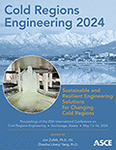Preliminary Finite-Element Modeling of Floating Sea Ice Impacting Vertical Piles with Accreted Ice
Publication: Cold Regions Engineering 2024: Sustainable and Resilient Engineering Solutions for Changing Cold Regions
ABSTRACT
The current approach to calculate ice design forces on coastal structural elements is to apply the crushing strength of thick sea ice over the width of the structural element, plus the width of any accreted ice bonded to the element. To evaluate the accuracy of this method, accreted ice samples from the Port of Alaska were harvested and tested for shear and compression strength. The resulting data were then used to calibrate a preliminary finite-element (FE) material model in Abaqus CAE 2022 using a concrete damaged plasticity model. Three simulations were created and evaluated: a uniaxial compression model of a cylindrical sample to verify the material model against the experimental results; a bare pile and ice floe interaction model; and an interaction model consisting of a vertical pile, accreted ice, and ice floe. Model results showed the modeled ice floes were extremely stiff, causing excessively large ice forces that greatly exceeded the design capacity of the pile. The model provided valuable insight into the complexities of numerical modeling of ice–ice–structure interaction and demonstrated that more sophisticated ice material models are needed for the ice floe.
Get full access to this chapter
View all available purchase options and get full access to this chapter.
REFERENCES
23.6.3 Concrete damaged plasticity. (n.d.). Abaqus 6.14 Analysis User’s Guide. http://130.149.89.49:2080/v6.14/books/usb/default.htm
Dempsey, J. P. (1991). The Fracture Toughness of Ice. In Ice-Structure Interaction (Issue March).
Derradji-Aouat, A. (2005). Explicit fea and constitutive modelling of damage and fracture in polycrystalline ice - Simulations of ice loads on offshore structures. Proceedings of the International Conference on Port and Ocean Engineering under Arctic Conditions, POAC, April, 225–238.
Derradji-Aouat, A. D. (2003). Multi-surface failure criterion for saline ice in the brittle regime. Cold Regions Science and Technology, 36(1–3), 47–70.
Derradji, A. A., & Evgin, E. (2001). Progressive damage mechanism for ductile failure for polycrystalline ice and its complementary brittle failure criterion. Proceedings of the International Conference on Offshore Mechanics and Arctic Engineering - OMAE, 4(April 2019), 15–22.
Elkady, A. (2021a). #21 ABAQUS Tutorial: Defining Concrete Damage Plasticity Model + Failure and Element Deletion. Youtube. https://www.youtube.com/watch?v=wy84XGamn3g
Elkady, A. (2021b). #22 ABAQUS Tutorial: Concrete Compression Cylinder Test. Youtube2.
Elkady, A. (2021c). #22 ABAQUS Tutorial: Concrete Compression Cylinder Test. Youtube2. https://www.youtube.com/watch?v=PTRQib7C6po&t=463s
Frederking, R. M. W., Svec, O. J., & Timco, G. W. (1988). On Measuring the Shear Strength of Ice. Proceedings of the 9th International Symposium on Ice, 3, 76–88. http://nparc.cisti-icist.nrc-cnrc.gc.ca/eng/view/accepted/?id=11f59b37-ce0c-425e-a802-97e1a170daa2
HDR, & CH2M Hill. (2015). Anchorage Port Modernization Project Ice Forces at the Port of Anchorage.
Langmann, J. (2023). Investigation of Ice Crushing Forces on Vertical Piles. MS Thesis: University of Alaska Anchorage.
Langmann, J. & Hamel, S. (submitted for review). Ice Specimen Retrieval and Coring Method for Accreted Ice on Vertical Piles subjected to Large Tidal Changes. Journal of Cold Regions Engineering.
Petrovic, J. J. (2003). Mechanical properties of ice and snow. Journal of Materials Science, 38(1), 1–6.
Peyton, H. R. (1966). Sea Ice in Cook Inlet.
Richter-Menge, J. A., & Jones, K. F. (1993). The tensile strength of first-year sea ice. Journal of Glaciology, 39(133), 609–618.
Schulson, E. M. (2001). Brittle failure of ice. Engineering Fracture Mechanics, 68(17–18), 1839–1887.
Sharapov, D., & Shkhinek, K. (2014). A method to determine the horizontal ice loads on the vertical steel structures which adfreeze to the ice level. Coastal Engineering, 88, 69–74.
Sharapov, D., Shkhinek, K., & Delvalls, T. Á. (2016). Ice collars, development and effects. Ocean Engineering, 115, 189–195.
Timco, G. W., & Weeks, W. F. (2010). A review of the engineering properties of sea ice. Cold Regions Science and Technology, 60(2), 107–129.
Tuhkuri, J., & Polojärvi, A. (2018). A review of discrete element simulation of ice – structure interaction.
Weeks, W. F., & Assur, A. (1967). The Mechanical Properties of Sea Ice. Cold Regions Research & Engineering Laboratory, September, 96.
Xiao, J., & Jordaan, I. J. (1996). Application of damage mechanics to ice failure in compression. Cold Regions Science and Technology, 24(3), 305–322.
Xu, Y., Hu, Z., Ringsberg, J. W., & Chen, G. (2019). Nonlinear viscoelastic-plastic material modelling for the behaviour of ice in ice-structure interactions. Ocean Engineering, 173(January), 284–297.
Information & Authors
Information
Published In
History
Published online: May 9, 2024
ASCE Technical Topics:
Authors
Metrics & Citations
Metrics
Citations
Download citation
If you have the appropriate software installed, you can download article citation data to the citation manager of your choice. Simply select your manager software from the list below and click Download.
